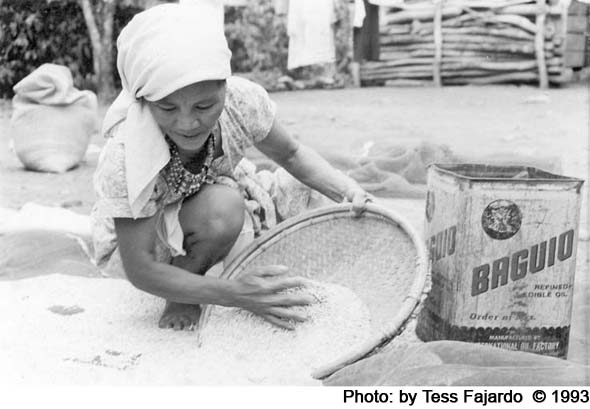
We ask a Filipino woman whether it might be good for Filipinos to shift some of their rice consumption to root crops and other sources of nutrition, she politely laughs at our clearly outrageous thought and says, “Rice makes us happy.”
Rice is also the biggest employer in the Philippines. Over a third of the population still works in agriculture, and rice is still the largest crop. And as we discover in several “rice communities” across the country, there are exciting shifts in the orthodoxy over what rice is planted and how it is grown.
In July, we spend several days with the family of a rice farmer, Delia, in Carmen town, Davao del Norte. Delia, her husband Romulo, two daughters, one son and three grandchildren, live in a simple but roomy house on the edge of their rice field. Behind the house is a tilapia-filled pond with papaya trees growing on one side. A handful of pigs are housed by the fish pond, and 15 chickens range free. Vitamin-rich kangkong grows at the far edge of the pond, and two towering jackfruit trees provide both shade and ingredients for delicious Ilonggo meals. Theirs is what we call a “rooted” life — that is, they eat mainly what they grow and raise.
And what they use are mostly locally based, including our bedding. On our first night, surrounded by village kids, we walk five minutes up the road to the house of a neighbor, Ging-Ging. She is about to finish weaving two rattan mats on a wooden loom in her backyard. While she weaves, she ticks off the math of her inputs, and we are convinced she would still make money on the P50 paid for each.
After attending a workshop by a local nongovernment organization a couple of years back, Delia started planting one of their three hectares with organic rice. She was an instant convert: “It is safer and the profit is bigger as expenses fell. With our two ‘chemical hectares,’ the rice traders who give us the loans are getting rich.”
After sleeping well on the new mats, we rise early with Delia’s family. It is the 15th of the month, which means that each family must send one member to help cut weeds along the irrigation canal; those who don’t show up are fined P100. This is one of several community tasks where all families participate for the greater good—in this case, keeping the canals free of weeds that would slow the water flow. The farmers move quickly, offering us their bolos so we can join in.
At the edge of the irrigation canal, Delia proudly shows us her “zero-chem” hectare and we discuss the traditional seeds she has planted. Part of the high expenses of chemical agriculture is the so-called “high-yielding” hybrid seeds that do not reproduce themselves and, therefore, farmers have to pay a lot for new ones each year. The traditional and “inbred” seeds that Delia and other organic farmers use are saved from the previous harvest or “in-bred” locally to work best in this particular area. Delia complains that the government’s agricultural extension agents sometimes give out free hybrid seeds, and that they mainly give seminars on chemical agriculture rather than support farming without chemicals.
Delia and the other farmers we meet are aware of the larger argument against traditional and inbred seeds and against organic agriculture: it is “backward,” unscientific and can never compete with the high-yielding seeds of chemical agriculture. Thus, it cannot feed the world. Africa is starving, the supporters of chemical farming say. China is buying up farm land in other countries to feed its own people. Hence, higher yields are needed to feed a hungry world.
The older farmers say that yes, at the beginning of the green revolution, the expensive seeds and chemical fertilizers and pesticides increased production. But Delia and her neighbors tell us of falling productivity over the years as soils became compacted and starved of the nutrients (that get replenished with organic farming). And debt-ridden farmers were often forced, by economic desperation, to cut back on the pesticides and fertilizers, thus reducing yields further — or even to sell their cherished land.
As we learn, Delia and all of her zero-chem neighbors are anything but backward; they are scientists in their own right, constantly experimenting with different seeds and different inputs and different amounts of water. They have locally made non-chemical “concoctions” to handle everything from rats to stem-boring insects to plant viruses. After using the new techniques for a couple of seasons, several say their yields are just below what they were with chemical farming. Others say their yields have stayed the same or actually gone up. One couple show us their zero-chem rice field where they had planted hybrid seed varieties with quite high yields.
How fast can organic farming be scaled up? The agriculture officer in the neighboring town of Dujali, whose mayor is a pro-organic former midwife, tells us that about 5 percent of Dujali’s rice farmers are currently using organic techniques. The local government’s goal is to raise that to 20 percent over the next few years.
While local government support is a big boost to organic farming, many farmers emphasize that support from the national government is even more desperately needed. If the Aquino administration follows through on its early vow to support organic farming, the future could be brighter for rice farmers and consumers across the country.
 Home | Aims and Objectives of Solidarity Philippines Australia Network | About Kasama
Home | Aims and Objectives of Solidarity Philippines Australia Network | About Kasama 
Search the SPAN Web